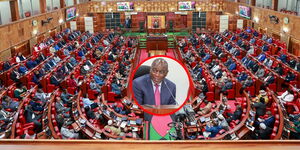Explained: Why Some Women Grow Facial Hair
Chances are, you have seen many women with facial hair growth and wondered why they look the same as men. Many people with this condition have, however, faced stigma and other related body-shaming treatments simply because people fail to understand the condition.
For many women, noticing hair growth on the face, particularly on the chin or jawline area, can be worrying. While it is less common than hair on arms or legs, it is more normal than most people realise.
Facial hair growth in women, often called hirsutism, is influenced by a number of factors, which include hormones, genetics, and sometimes medical conditions.
According to Johns Hopkins Medicine, hirsutism is a condition where women develop hair in areas typically associated with male patterns, and while it may be distressing, it is often treatable and rarely dangerous.
The growth of facial hair, usually around the chin area, is linked to higher levels of male hormones, known as androgens, exhibited in women.
According to experts, one of the most common causes of facial hair growth is a result of polycystic ovary syndrome (PCOS), a condition that affects hormone levels and often causes irregular periods, acne, and excess hair growth on the face and body.
Genetics also plays a significant role, where some women naturally inherit stronger hair follicles and higher sensitivity to hormones. This, according to experts, also means that if other women in the family have facial hair, it is likely to appear in younger generations too.
Hormonal changes at puberty, during pregnancy, or at menopause can trigger increased facial hair growth. This happens because fluctuations in hormones, particularly androgens like testosterone, affect the hair follicles.
During these life stages, either the levels of androgens rise or the hair follicles become more sensitive to them, signalling fine facial hairs to grow thicker, darker, and more noticeable.
In puberty, the body produces more sex hormones; in pregnancy, hormone shifts temporarily boost androgen effects; and at menopause, declining estrogen levels make the relative effect of androgens stronger, all contributing to increased facial hair.
At the same time, certain medications that influence hormone levels can also lead to increased facial hair growth in women. Drugs such as anabolic steroids, some hormonal contraceptives, and medications can raise androgen levels or mimic their effects, stimulating hair follicles to produce thicker and darker facial hair.
However, doctors say that it is important to note that sudden or excessive hair growth may signal an underlying medical issue, such as adrenal or ovarian disorders. Women experiencing rapid changes in facial hair should consult a healthcare professional.
Treatment and Elimination
For many women, facial hair is a cosmetic rather than medical concern, and there are several safe treatment options available, ranging from temporary methods like shaving, waxing, or depilatory creams to more long-term solutions like laser hair removal.
Additionally, some people with the condition use the threading technique, which is a hair removal technique that uses a thin, twisted cotton or polyester thread to remove unwanted hair from the root. The thread is rolled over the skin in a way that traps hairs and pulls them out, making it precise and effective for shaping eyebrows, removing upper lip hair, or tidying other small areas on the face.
Electrolysis is another permanent option for women seeking to remove hair completely, which works by targeting individual follicles and preventing hair from growing back.
Doctors may prescribe hormonal therapies such as oral contraceptives or anti-androgen medications to reduce hair growth over time, particularly when it is linked to conditions like PCOS.
Lifestyle changes, including weight management and diet adjustments, can also reduce hormone imbalances and help control unwanted hair in some women.












